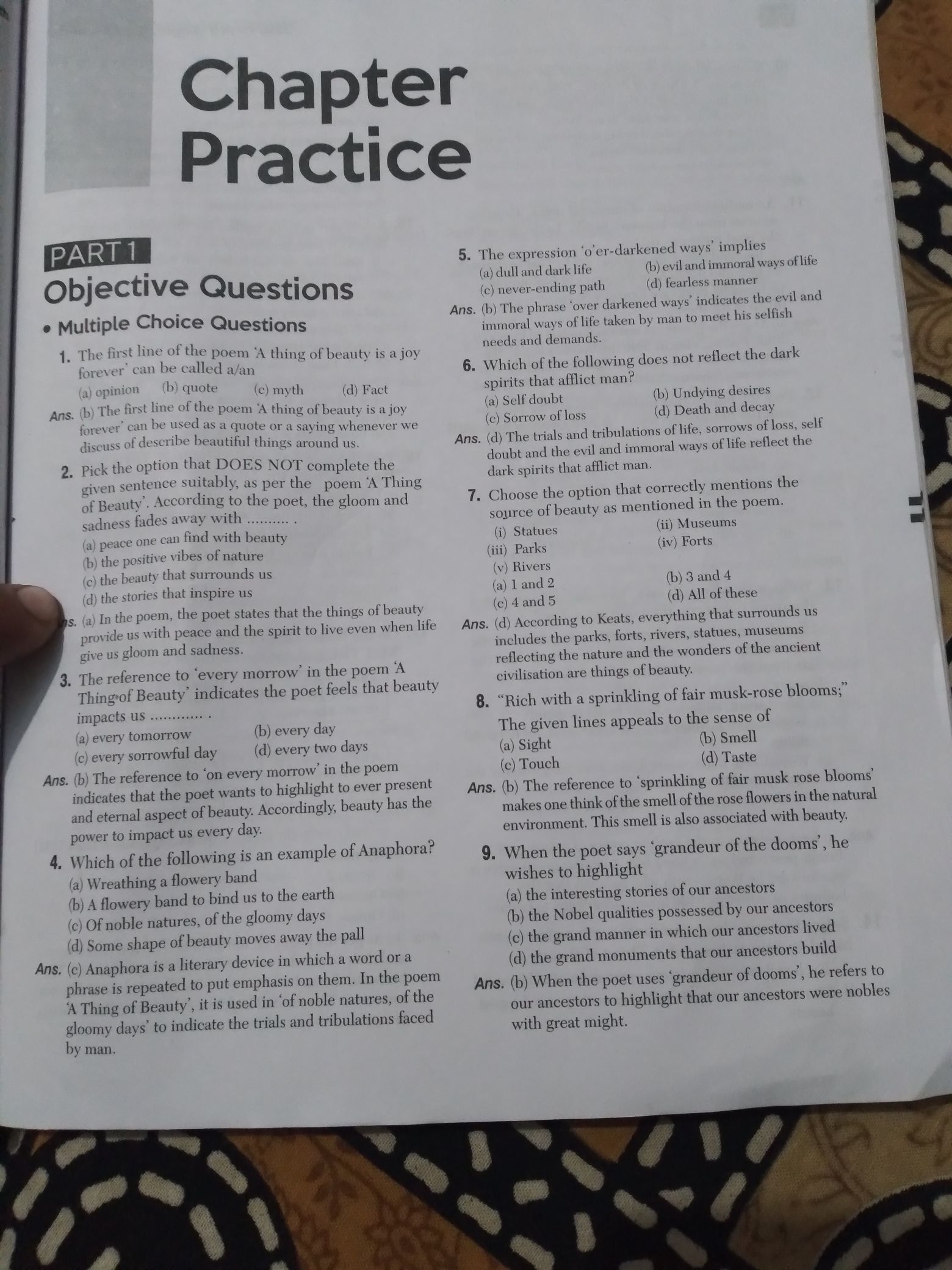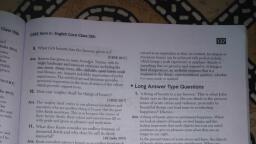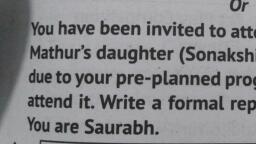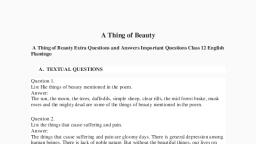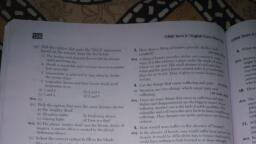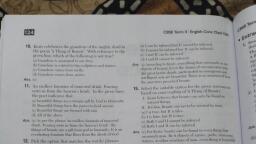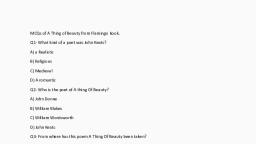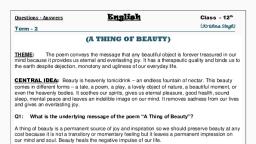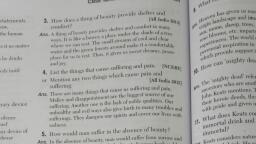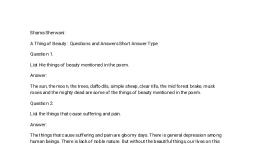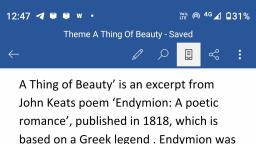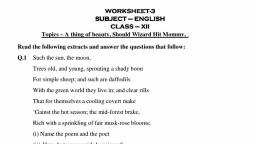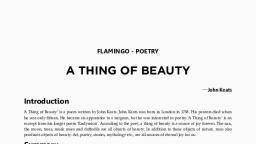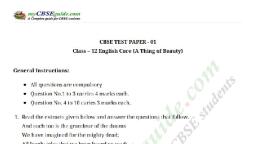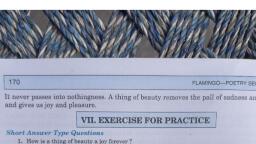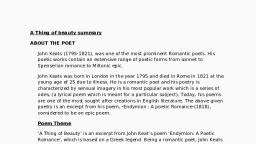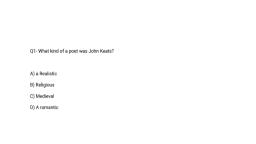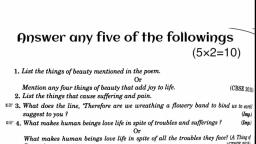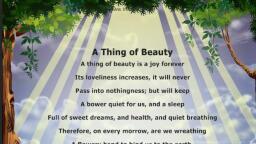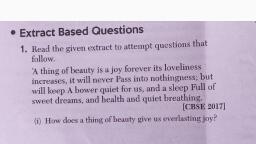Page 1 :
Chapter, Practice, , 5., , , , , , Ane, Objective Questions, , e Multiple Choice Questions, , , , forever’ can be used as a quote or ¢, of describe beautiful thin, , aying whenever we, , , , , as iycconvt ints, , 9, Pick the option that DOES NOT complete the, given sentence suitably, as per the poem ‘A Thing, of Beauty’. According to the poet, the gloom and, sadness fades away with ........... i, , a) peace one can find with beauty, , hb) the positive V ibes of nature, , ¢) the beauty that surrounds us, , , , d) the stories that inspire us, , a) In the poem, the poet states that the things of beauty, provide us with peace and the spirit to live even when life, give us gloom and sadness., , Ss., , 3. The reference to ‘every morrow in the poem ‘A, Thingof Beauty’ indicates the poet feels that bea, impacts US «..-.+++00++ ‘, a) every tomorrow, c) every sorrowful day, , Ans. (b) The reference to ‘on every morrow’ in the po, , indicates that the poet wants to highlight to ever present, and eternal aspect of beauty. Accordingly, beauty has the, power to impact us every day., , 4. Which of the following is an example of Anaphora?, (a) Wreathing a flowery band, (b) A flowery band to bind us to the earth, (c) Of noble natures, of the gloomy days, (d) Some shape of beauty moves away the pall, , a literary device in which a word or a, , d to put emphasis on them. In the poem, , it is used in ‘of noble natures, of the, , d tribulations faced, , uty, , (b) every day, (d) every two days, em, , Ans. (c) Anaphora is, phrase is repeate, ‘A Thing of Beauty’,, gloomy days’ to indicate the trials an, , by man., , Ans. (b) The phrase ‘over darker, , ’, “1 ] e, ; . The first line of the poem ‘ . . a, 1 ! i © poem ‘A thing of beauty is a joy, forever’ can be called a/an a 6, pinion b) quote (ce) myth (d) Fact, Ans. (b) T ,e first line of the poem ‘A thing of beauty is a joy, , Ans., , 7. Choose the option that, , Ans. (d) According to Keats, every’, , Ans. (b) The refe, , arkened ways’ implies, , The expression ‘o’er-d, (b) evil and immoral ways of life, , (a) dull and dark life, , (c) never-ending path (d) fearless manner, , ned ways’ indicates the ev il and, , immoral ways of life taken by man to meet his selfish, , needs and demands., Which of the following does not reflect the dark, spirits that afflict man?, (a) Self doubt, , (c) Sorrow of loss, , (d) The trials and tribulations of life, doubt and the evil and immoral ways of life, dark spirits that afflict man., , correctly mentions the, source of beauty as mentioned in the poem., (ii) Museums, , (iv) Forts, , Ss, , , , (b) Undying desi, (d) Death and decay, , sorrows of loss, self, reflect the, , , , (i) Statues, (iii) Parks, (v) Rivers, (a) land 2, (c)4and5, , (b) 3 and 4, , (d) All of these, , thing that surrounds us, des the parks, forts, rivers, statues, museums, , inclu, e wonders of the ancient, , reflecting the nature and th, civilisation are things of beauty., , 8. “Rich with a sprinkling of fair musk-rose blooms;”, , , , The given lines appeals to the sense of, , (a) Sight (b) Smell, , (c) Touch (d) Taste, , rence to ‘sprinkling of fair musk rose blooms’, makes one think of the smell of the rose flowers in the natural, , environment. This smell is also associated with beauty., , 9. When the poet says ‘grandeur of the dooms’, he, , wishes to highlight, , (a) the interesting stories of our ancestors, , (b) the Nobel qualities possessed by our ancestors, , (c) the grand manner in which our ancestors lived, , (d) the grand monuments that our ancestors build, , Ans. (b) When the poet uses ‘grandeur of dooms’, he refers to, , our ancestors to highlight that our ancestors were nobles, , with great might.
